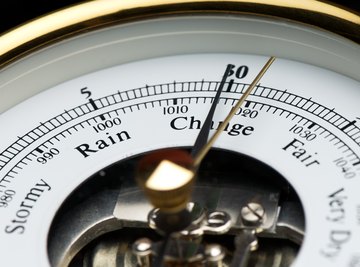
When you talk about air pressure and water vapor, you're talking about two different, but interrelated things. One is the actual pressure of the atmosphere on the Earth's surface -- at sea level it's always around 1 bar, or 14.7 pounds per square inch. The other is the proportion of this pressure attributable to water vapor in the air, or saturated vapor pressure, which rises or falls with water vapor levels.
Lawful Pressure
Air pressure is ruled by Dalton's Law. John Dalton was the nineteenth century scientist who first stated that the total pressure of the air is the sum of the partial pressures of all of its components. These components include major and minor gases, water vapor and particulate matter -- tiny solid pieces, such as dust and smoke. The vast majority of pressure is contributed by nitrogen, which comprises around 78 percent of the Earth's atmosphere. Oxygen is second, at around 21 percent. Argon, which comes in third, makes up only 1 percent of the Earth's atmosphere. All other gases normally exist in proportions of less than 1 percent -- except for highly variable water vapor.
Shifting Gases
The amount of air composed of water vapor is typically 1 to 4 percent. All gases in the air, including water vapor, exist in constantly shifting proportions. Since their total must equal 100 percent, an increase or decrease in the percentage occupied by water vapor results in a decrease or increase of the percentages of other gases.
Stable Air
"Atmospheric pressure" is the total pressure exerted by the Earth's atmosphere. Since atmospheric pressure at sea level is always approximately 1 bar, an increase in water vapor at any given location changes it very little. At high altitudes overall atmospheric pressure is lower and increases in water vapor have a greater -- though still relatively small -- impact.
Changing Saturation
However, there's another "air pressure" measurement that does change significantly with increasing water vapor. This is the saturated vapor pressure, or the proportion of atmospheric pressure attributable to the water vapor itself. The amount of water vapor in the air, or humidity, depends on evaporation. Evaporation depends on water temperature -- as water warms, more molecules evaporate from its surface. Water in cooler air evaporates less and water in warmer air evaporates more and faster -- hence the relationship between heat and humidity. Saturation is when the evaporation rate equals the condensation rate: in other words, equal numbers of water molecules are entering and leaving the water's surface. Saturated vapor pressure rises with an increase in water vapor.
About the Author
Angela Libal began writing professionally in 2005. She has published several books, specializing in zoology and animal husbandry. Libal holds a degree in behavioral science: animal science from Moorpark College, a Bachelor of Arts from Sarah Lawrence College and is a graduate student in cryptozoology.
